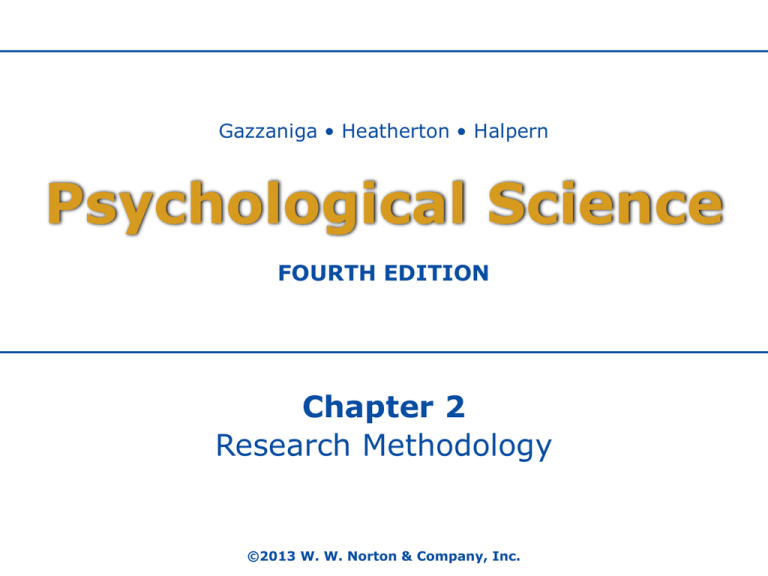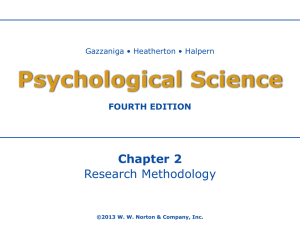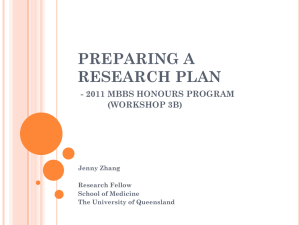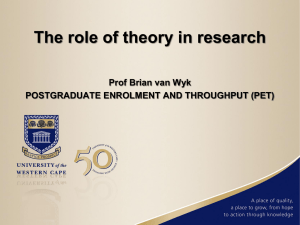PsychScich02
advertisement

Gazzaniga • Heatherton • Halpern Psychological Science FOURTH EDITION Chapter 2 Research Methodology ©2013 W. W. Norton & Company, Inc. 2.1 What Is Scientific Inquiry? Learning Objectives • Describe the scientific method • Differentiate between theories, hypotheses, and research What Is Scientific Inquiry? • Psychologists study the what, when, and why of behavior and mental processes • Scientific inquiry utilizes the scientific method – More objective than casual observations – Systematic: Procedures follow orderly steps that are carefully planned – Free from bias The Scientific Method Depends on Theories, Hypotheses, and Research The scientific method has three essential elements: • Theory: interconnected ideas or concepts used to explain prior observations and to make predictions • Hypothesis: a testable prediction about the outcome that would best support the theory • Research: the systematic and careful collection of data Theories Should Generate Hypotheses • A good theory produces a wide variety of testable hypotheses: - Jean Piaget’s theory of infant and child development generated thousands of hypotheses and scientific papers - Freud’s theory that dreams served a wish fulfillment function generated few testable hypotheses Unexpected Findings Can Be Valuable • Many significant scientific findings are the result of serendipity: – Late 1950s: Physiologists Wiesel & Hubel hypothesized certain brain cells in cats would respond when cats looked at dots on slides – After much effort they were not getting the expected results – When their projector jammed, the slide produced a visual “edge” on the screen – They discovered that the cells respond to lines and edges, not dots “Itch Gene” Researchers have uncovered a potential relief for itchiness. The strange thing is that they were trying to eliminate pain. This ScienCentral News video explains how an accidental discovery may lead to new anti-itch treatments. Featuring: Zhou-Feng Chen, Washington University 2.2 What Types of Studies Are Used in Psychological Research? Learning Objectives • Distinguish between descriptive studies, correlational studies, and experiments • List the advantages and disadvantages of different research methods • Explain why random sampling and random assignment are important when conducting research studies What Types of Studies Are Used in Psychological Research? • There are three main types of designs: descriptive, correlational, and experimental • What’s a variable? – Operational definition – Quantification Descriptive Studies Involve Observing and Declassifying Behavior • Descriptive studies: Involve observing and noting the behavior of people or other animals to provide a systematic and objective analysis of behavior – Naturalistic observation: passive observation – Participant observation: active involvement • Developmental designs – Longitudinal – Cross-sectional Observer Bias • Observer bias: systematic errors in observation that occur because of an observer’s expectations • Experimenter expectancy effect – Example: Expectations altered how students treated rats, which influenced the speed at which the rats learned to run a maze. The students were not aware of their biased treatment of the animals (Rosenthal & Fode, 1963) Correlational Studies Examine How Variables Are Related • Correlational studies: examine how variables are naturally related in the real world • Researchers do not attempt to alter variables • Researchers cannot draw causal conclusions from correlationalstudies “Sleep and Addiction” A bad night’s sleep for a child could mean more, in the long run, than just a cranky kid. As this ScienCentral News video reports, new research suggests that childhood sleep troubles may be a potential marker for alcohol, tobacco, and drug addiction later in life. Directionality Problem • Directionality problem: Researchers find a relationship between two variables but cannot determine which variable may have caused changes in the other variable • Example: Sleep (A) and stress (B) are correlated, but… – Does less sleep cause more stress? (A → B) – Does more stress cause less sleep? (B → A) Third Variable Problem • Third variable problem: Researchers cannot be confident that an unmeasured variable is not the actual cause of differences in the variables of interest • Example: Drinking before driving (A) is correlated with being distracted while driving (B) – Stress (C) causes some people to drink before driving (C → A) – Stress (C) causes some people to be distracted while driving (C → B) Ethical Reasons For Using Correlational Designs • Some research questions require correlational research designs for ethical reasons • Example: – Do soldiers who experience severe trauma during combat have more difficulty learning new tasks after they return home compared to soldiers who have experienced less-severe trauma? – It would be unethical to induce trauma in some soldiers so that you could compare the different groups Making Predictions • By establishing correlations between variables, researchers are able to make predictions • Example: – Correlational research has identified a strong relationship between depression and suicide – Clinical psychologists often assess symptoms of depression to determine suicide risk An Experiment Involves Manipulating Conditions • Experiment: Researcher manipulates one variable to examine its effect on a second variable – Independent variable: variable that is manipulated – Dependent variable: variable that is measured • Experimental group: the treatment groups that receive the intervention • Control group: a comparison group that does not receive the intervention (or receives one unrelated to the independent variable) Examining Causality • The independent variable is assumed to be the cause of any change in the dependent variable • Such a conclusion assumes rigorous control • Researchers must minimize the possibility that anything other than the independent variable will affect an experiment’s outcome • A confound is anything other than the independent variable that affects a dependent variable Random Sampling and Random Assignment Are Important for Research • Psychologists want to generalize findings from a sample of individuals to the population of people beyond the study • Random sampling: Every person in the population has an equal chance of being selected; most researchers use a conveniencesample • External validity: the degree to which the findings can be generalized outside the laboratory Selection Bias • Selection bias: Groups are not equivalent because participants in different groups differ in unexpected ways that affect the dependent variable • Example: In a study of the effects of alcohol, one group is assigned to drink tonic water; another group is assigned to drink alcohol • How would you know if the people in the different conditions of the study are equivalent? Random Assignment • You can never be sure that you have assessed all possible factors that may differ between the groups • Random assignment: Each research participant has an equal chance of being assigned to any level of the independent variable • Random assignment balances out known and unknown factors, increasing the likelihood that the groups are equivalent “Red Sways Men” The way to a man’s heart on Valentine’s Day? Wear red. This ScienCentral News video explains that there is scientific evidence for the attractive power of red. 2.3 What Are the Data Collection Methods of Psychological Science? • Distinguish between five methods of data collection • List the advantages and disadvantages of different methods of data collection • Discuss the use of animal models in psychological research • Identify ethical issues associated with psychological research What Are the Data Collection Methods of Psychological Science? • Researchers must choose a data collection method • The first step is to determine the level of analysis a particular question is addressing (biological, individual, social, cultural) • Data collection methods must be appropriate for questions at a particular level of analysis • Culturally sensitive research: studies that take into account the role that culture plays in determining thoughts, feelings, and actions Observing Is an Unobtrusive Strategy • Observational techniques: systematic assessment and coding of overt behavior • Should the study be conducted in the laboratory or in a natural environment? • How should the data be collected? • Should the observer be visible? • Reactivity: Presence of the observer alters the behavior of those being observed • The Hawthorne Effect Case Studies Examine Individual Lives and Organizations • Case study: intensive examination of unusual people or organizations • Examples: – The goal of an organizational case study is to determine which practices led to success or failure – Case studies of people with psychological disorders are the type used most frequently in psychology • Problems: Case studies are subjective and have a small sample size Asking Takes a More Active Approach • Compared to observation, asking people about themselves is a more interactive way of collecting data • Self-report methods such as questionnaires or surveys are used to gather data from a large number of people in a short time • Interviews • Experience sampling Self-Report Bias • Problem with “asking-based” methods of data: It’s difficult to discern an honest or true response • Socially desirable responding/faking good: Person responds in a way that is most socially acceptable • Better-than-average effect: People tend to describe themselves in positive ways that are not necessarily true Response Performance Measures the Processing of Information • Response performance: Researchers quantify perceptual or cognitive processes in response to a specific stimulus • Three major types: – Reaction time – Response accuracy – Stimulus judgments Body/Brain Activity Can Be Measured Directly • Psychophysiological assessment: Researchers examine how bodily functions (physiology) change in association with behaviors or mental states (psychology) • A polygraph measures physiological activity (e.g., heart rate, perspiration rate, blood pressure) related to behaviors or mental states “Brain ‘Boot Camp’ Makes You Smarter” Is getting more exercise among your New Year’s Resolutions? What about some training for your brain? Researchers have put people through a series of brain exercises—a brain boot camp— and found that exercise for your brain pays off. Electrophysiology • Electrophysiology: data collection method that measures electrical activity in the brain • Electroencephalograph (EEG):a device that measures brain activity – Produces electroencephalograms, which reflect all brain activity; are too “noisy” or imprecise to isolate specific responses to particular stimuli • Event-related potential (ERP): By averaging across many trials, brain activity in response to a specific stimulus can be observed Brain Imaging • Positron emission tomography (PET): provides a computer-aided reconstruction of the brain’s metabolic activity by tracking a radioactive substance • Magnetic resonance imaging (MRI): A scanner produces a powerful magnetic field that the tissues in the brain respond to • Functional magnetic resonance imaging (fMRI): measures blood flow indirectly by assessing changes in the blood’s oxygen level Transcranial Magnetic Stimulation • Transcranial magnetic stimulation (TMS): A very fast, powerful magnetic field disrupts brain activity momentarily in a specific brain region • Example: Placing a TMS coil over areas of the brain involved in language will temporarily disrupt a person’s ability to speak • Powerful method for examining which brain regions are necessary for specific psychological functions “Science Tools: Brain Cell Imaging” The brain of a mammal is one of the most complex things in the universe. But studying brains has become easier thanks to some complicated, high-tech equipment. In this ScienCentral video, we visit Tonegawa Lab at MIT’s Picower Institute Learning and Memory to see their two-photon microscope and electrophysiology lab. Research with Animals Provides Important Data • Many important research findings in psychology have been obtained by studying the behavior of nonhuman animals • Forces that control the behaviors of all animals exert their effects in similar ways • For ethical reasons, some research cannot be conducted with humans • Transgenic mice are produced by manipulating the genes in developing mouse embryos There Are Ethical Issues to Consider • When scientists select a research method, they must know the ethical issues involved • They must also adhere strictly to the relevant ethical guidelines maintained by all colleges, universities, and research institutes • Institutional review boards (IRBs): review all proposed research to ensure that it meets scientific and ethical standards Privacy • Privacy is a prominent ethical concern • Is it okay to observe people without their knowledge? • When people are asked for information, should some topics not be raised because they may be too personal or otherwise inappropriate? • Researchers must consider how observation and questioning may affect the individualsthey are studying Access to Data • Researchers must consider who will have access to the data they collect • Participant confidentiality should always be guarded carefully so that personal information is not linked publicly to a study’s findings • The quality and accuracy of data often depend on participants’ certainty that their responses will be kept confidential • Anonymity is not the same as confidentiality Informed Consent • People who volunteer for psychological research have the right to know what will happen to them during the course of the study • Ethical standards require informed consent: People are given all relevant information that might affect their willingness to participate • If deception is used, a careful debriefing must take place after the study’s completion Relative Risks of Participation • Researchers have to think carefully about the potential for risk to participants • Institutional Review Boards (IRBs) look at the relative trade-offs between risk and benefit • The risk/benefit ratio is an analysis of whether the research is important enough to warrant placing participants at risk 2.4 How Are Data Analyzed and Evaluated? • Identify three characteristics that reflect the quality of data • Describe measures of central tendency and variability • Describe the correlation coefficient • Discuss the rationale for inferential statistics 2.4 How Are Data Analyzed and Evaluated? • What characteristics make data good? • What are some of the statistical procedures that researchers use to analyze data? Good Research Requires Valid, Reliable, and Accurate Data • Internal validity: Do the data collected address your question? • Reliability: Dothe data collected vary substantially over time? • Accuracy: Is the measure from which the data are derived error free? – Random error: Amount of error introduced into each measurement differs each time – Systematic error: Amount of error introduced into each measurement is constant Descriptive Statistics Provide a Summary of the Data • The first step in evaluating data is to inspect the raw values for errors in data recording • Then, data are summarized using descriptive statistics • Central tendency: describes a typical response (mean, median, mode) • Variability: describes how widely dispersed the values are about the mean (standard deviation) Correlations Describe the Relationships between Variables • Descriptive statistics can also be used to summarize how two variables relate to each other • The first step in examining the relationship between two variables is to create a scatterplot • correlation coefficient: a statistical value between −1.0 and +1.0 indicating the type (negative/positive) and strength of the relationship between two variables Inferential Statistics Permit Generalizations • Inferential statistics: used to determine whether differences actually exist in the populations from which samples were drawn • Inferential statistical techniques are used to determine if observed differences between sample means (e.g., the driving performances of sober and drunk drivers) are likely due to chance or if they reflect differences in populations • Results deemed unlikely to be due to chance are statistically significant Meta-Analysis • Meta-analysis: a type of study that involves the analysis of multiple analyses • With meta-analysis, many studies that have addressed the same issue are combined and summarized in one “study of studies” • Because meta-analysis combines the results of separate studies, many researchers believe that meta-analysis provides stronger evidence than the results of any single study








